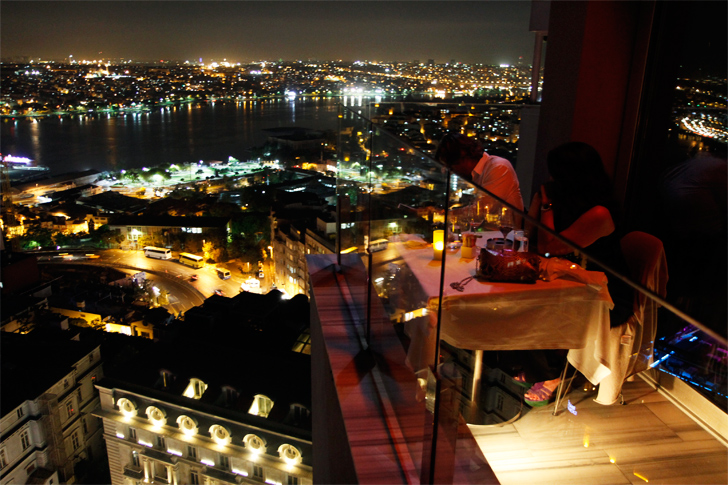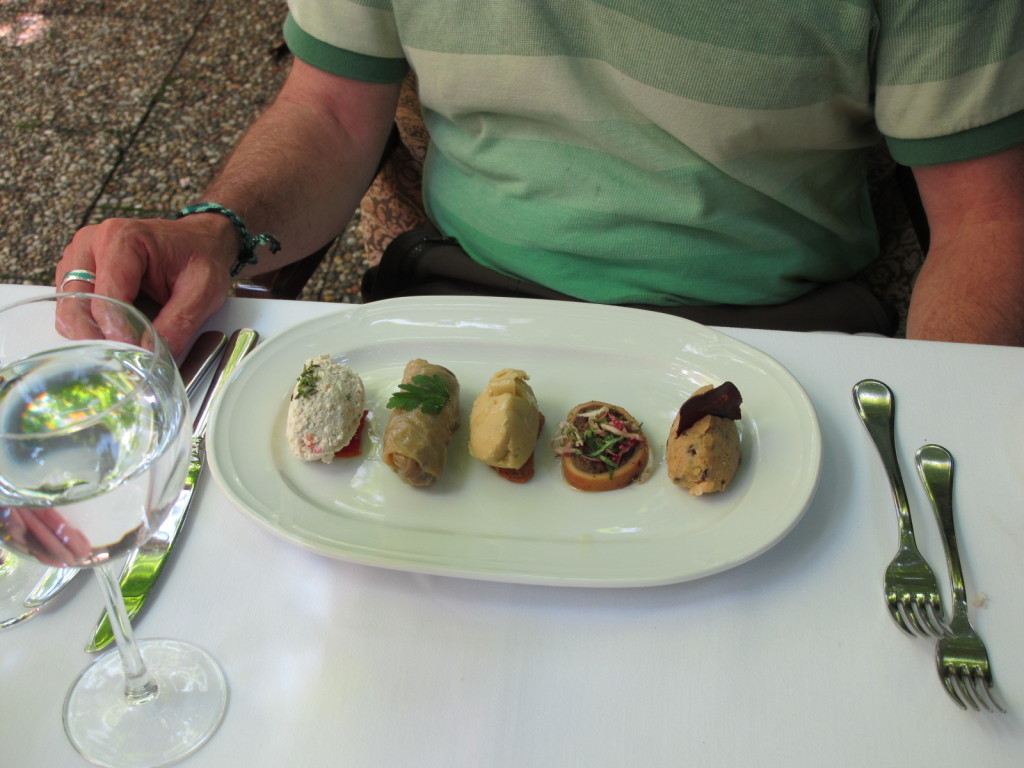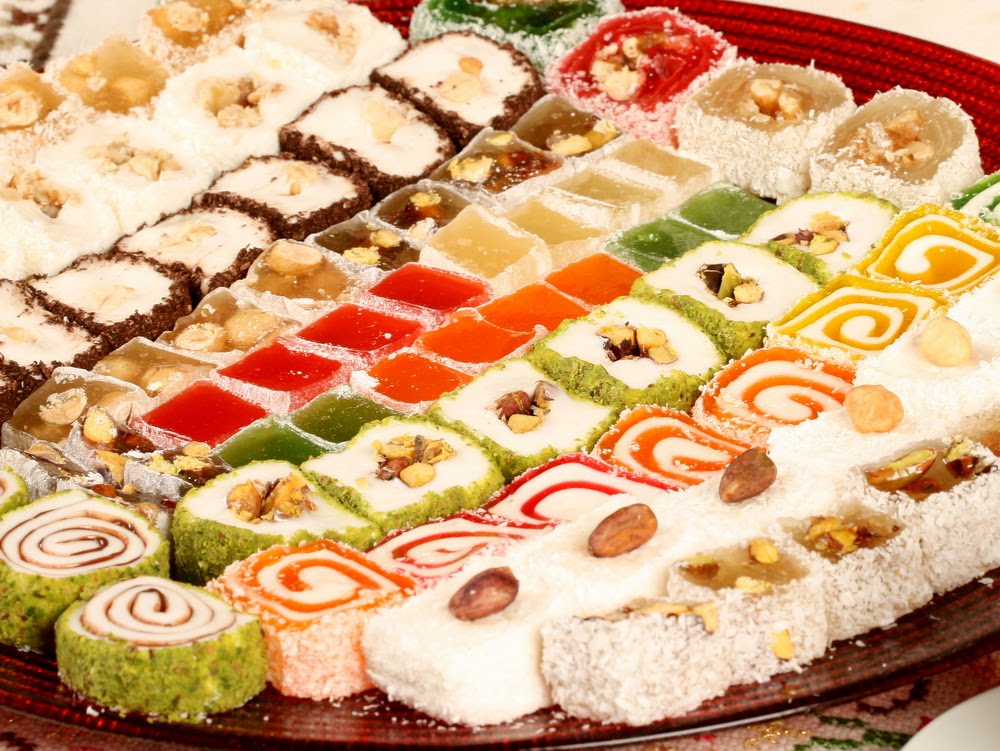Astride two continents in the city that T.S. Elliot once phrased “the still point of the turning world,” Istanbul’s opulent past merges with the vibrant present, where the juxtaposition of Occidental and Oriental — from the Danube and the Balkans, from Arabia and North Africa – melds ingredients and flavors with the Turkish heritage in a creative fusion cuisine for the adventuresome palate.

The Blue Mosque (Photo: Bill Strubbe)
With the glorious Dolmabahce and Topkapi Palaces, hallowed Blue Mosque and Hagia Sophia Church, the magical Basilica Cistern, shopping in the covered Grand Bazaar, steaming in the Turkish Baths, it’s easy to busy oneself all day with nary a moment to slow down enough to eat. On this third visit to Istanbul we simply did the perverse: skipped most of the sites and planned our days around indulging in Istanbul’s considerable culinary delights.
Consume with a View
Chef Mehmet Gurs, Turkey’s closet thing to a celebrity chef who pioneered Istanbul’s contemporary restaurant scene, possesses Midas magic in any restaurant he wields a knife. Mikla, perched atop the 18-story Marmara Pera Hotel, offers a panoramic view to flabbergast with food to match. We went all out and ordered mint pea soup, smoked mackerel mousse with aged kasar cheese, the fabled lamb entrecôte with apricot comfit. For dessert we splurged and ordered two (we usually split one): star anise and fennel-pear terrine with basil ice cream, and warm mulberry soup served with cinnamon crumbs and tahini ice cream – a stellar combo! In 2012, Mikla launched its visionary New Anatolian Kitchen where ingredients from Turkey are sourced, enhancing understanding its traditions and people, blending ancient and new culinary techniques. And for those who to make a full evening out of it, there’s also a verdant rooftop bar, mellow DJ-orchestrated tunes, and a rooftop swimming pool for sizzling nights.

Dining with a view at Mikla. (Photo via Flickr)
Atop a 19th-century building in Beyoglu District, the elegant, minimalist concrete and glass design of the aptly named 360 Istanbul serves to emphasize the magic carpet view of the city and Bosphorus. Here, Chef Mike Norman concocts a magical fusion of Turkish, Oriental and Mediterranean cuisine. Mouth-watering dishes include lamb loin confit poached for five hours in olive oil, Lebanese kibbe meatballs stuffed with walnuts, and their 360 Alternative Pizza. We ordered beetroot marinated salmon; duck and chestnut ravioli served with spinach root and pomegranate seed;, and sesame seared rock bass, with shrimp risotto and minted asparagus. Three interconnecting bars – 360 Bar, Lounge Bar and Fire Bar, and entertainment on week-ends make this one of the most lively, happening spots in Istanbul.
From a wood-fired oven wafts the aroma of baking flatbreads as we step into the stylish contemporary Turkish atmosphere of Ulus 29, the imprint of world-famous designer Zeynep Fadılloğlu immediately discernable in the cut-glass chandeliers. Situated on a hillside between the first and second Bosphorus Bridges, a surrounding terrace garden serves as outdoor dining space in warm weather. Though sushi, grouper carpaccio and duck liver raviolis beckon, Ulus 29 shines with its interpretations of traditional dishes: fillets of lamb with smoked eggplant and pilaf, Köfte 29 (meatballs), and kebab with yoghurt. We start with a house favorite; lahmacun. In contrast to the usual copious topping of lamb, this version is far lighter with lean beef; more like a chic pizza. Another fine choice is the crispy borek stuffed with duck instead of the traditional minced meat, the accompanying pomegranate sauce a perfection of sweet and sour.
Just Say No to Fusion!
Asitane is located in the foot hills overlooking the Golden Horn in the shadow of the Chora Church, famous for Byzantine mosaics. Shortly after settling outside on the terrace, we’re joined by the owner, Batur Durmay. He explains that after several years of research in the culinary archives of the Dolmabahce and Topkapi Palaces, Asitane compiled and tested hundreds of forgotten recipes, with only the most delicious making the final menu cut. One dish — ayva kalyasi; lamb, quince and chickpeas cooked in a grape molasses — was served at a feast for Suleiman’s the Magnificent’s sons in 1539. Under the guidance of their “Food Archeologist” Engin Turker, the kitchen team remains loyal to the ingredients and style of the original recipes. Batur smiles and adds, “This is one restaurant where the word ‘fusion’ is a bad word.” Since we cannot make up our minds, Batur orders his favorites. For starters we taste the grilled Circassian cheese with oyster mushrooms, which is killer. We share the sea bass biryan, roasted fish stuffed with walnuts and spices, served with saffron and rose water dressing; and a unique dish of a cantaloupe stuffed with ground lamb, rice, nuts, currants and spices cooked in a light sauce. Dessert is helatiye, milk pudding infused with gum mastic, served with almonds, pistachios, and seasonal fruits in rose water syrup.

Appetizers plate at Asitane. (Photo: Bill Strubbe)
Above the entrance to the Grand Bazaar, Pandeli is accessed via a narrow winding stone staircase opening into a domed room with exquisite, turquoise tiles and simple wooden tables – ones next to the windows overlooking the market are primo. Before the onslaught of nouvelle Turkish cuisine, Pandeli was feted as the place to eat in Istanbul. Long past its glory days, it’s historic and atmospheric – if not a bit of a tourist trap, but from the vast, traditional Turkish menu, we receive plentiful servings, leaving us satiated and happy. We begin with an assortment of appetizers — tender artichoke hearts, dolmas, and tasty white dry beans. For the main courses we order eggplant with chicken kebab, and a baked lamb dish, perfectly tender. For dessert, we choose ground almond cookies, and the quintessential Turkish tavukgöğsü, chicken breast cook in milk, mixed with sugar and cracked rice, spiced with cinnamon. Really, you’d have no clue it was meat! Be sure to order a tart glass of fresh pomegranate juice to accompany your meal.
Kid’s Stuff: Turkish Delight and Orchid Ice Cream
You’d have to be seriously adult not to be insanely curious about an ice cream that can be pulled like taffy and requires a knife and fork to eat. When my Turkish friend explains that it takes forever to melt, I thought what a fun treat on this sunny and warm day. Salepi dondurma, Orchid Ice Cream, is a unique Turkish treat not to be missed at Ali Usta Ice Cream in the upscale Moda neighborhood. For 35 years, Ali Kumbasar and his brothers have been producing the silky smooth orchid ice cream, the vital ingredient being salepi, an alabaster flour ground from the dried tubers of a wild orchid collected from the Anatolian Plateau. Kids will clamor for the flamboyant cherry or apricot, but we tried the vanilla and savored the unique aftertaste: nutty, shitake mushrooms, with a hint of goat cheese, and an indecipherable faint fragrance.
As did I, most Westerners first encounter with Turkish Delight was while reading The Lion, Witch and Wardrobe, where Edmund is tempted to evil by the Witch with chewy Turkish Delights. Originally made with honey, molasses and flour, Haci Bekir in 1777 altered the lokum formula with sugar and starch and opened a shop. Bekir became famous for the quality of his sweets and was appointed “Chief Confectioner” to the Ottoman Court. As the oldest company in Turkey and one of the 100 oldest in the world, Bekir’s great-great grand-children now run the business, Ali Muhiddin Haci Bekir Confectioners. Though Turkish Delight can be enjoyed just about anywhere, visit the restored original shop, now a protected landmark, in Bahcekapi District. (Hamidiye Caddesi No. 81) The traditional, delicate mastic flavor and pale pink rose water ones are my favorite, but they also come in a kaleidoscope of colors and flavors: lemon, mint, apricot, current, pomegranate, cinnamon, coffee and apple, as well as variations studded with pistachios, nuts and coconut.

Platter of Turkish Delight (Photo: Bill Strubbe)
Trending Now: Dining Hot Spots
Istanbul’s hot eatery of the moment is Yeni Lokanta, Chef Civan Er’s latest venue to feature his considerable culinary skills. Yeni Lokanta’s spare interior resembles a French bistro; a geometric black-and-white floor, green glass lampshades, Iznik Tiles, copper pots instead of bread baskets, and well-trained wait staff who clearly take pride in their workplace. Yeni Lokanta’s blessedly brief lunch and dinner menu offers salads, pastas, and lamb and fish dishes, all several notches above expectations. The sourdough bread arrives warm from the stone oven, with a side dish of olive oil whisked with smoked lor Peyniri, similar to ricotta. The salad of lettuce, rocket and mint is tossed with almonds, grapes and strawberries, dressed with sumac syrup, a traditional Mediterranean plant on a culinary comeback. The rich hummus is accompanied by a grape and zatar compote; the grilled octopus with purslane is sublime. For dessert we choose the milk pudding fritters coated in kadayif pastry, served with smoked buffalo milk ice cream. Everything, sublime and outrageous.
Housed in a 115-year-old school building, Cezayir sprawls through classrooms of varying levels of rambunctiousness and energy. We passed through a saffron colored café with original floor tiles, steam radiators and a long wooden bar, where we order their signature cocktail called Cezayir’s Very Own; an astringent mixer of scotch, grapefruit juice, and Benedictine, an herbal liqueur supposedly developed by at the monks at Abbey of Fecamp; the recipe is a closely guarded trade secret, known only to three living souls. In the more formal dining room with brash green walls, silver sprayed chairs and crystal chandelier — a wondrous amalgam of both glam and kitsch that somehow works — we partake in an array of Cezayir’s inventive Turkish meze with international twists; Turkish samosas with Indian spices, prawns wrapped in pastry, cabbage dolmas, and the börek grilled spinach and cheese pastry. Since we ate so many meze, for the main course we split a rich seafood paella. For dessert, the perfectly simple fig parfait.
Chop, Cook…Then Chow!
Spice up your visit to Istanbul with a hands-on cooking class. Several wonderful options featured below.
Dutch Chef Eveline Zoutendijk established the first cooking school, Cooking Alaturka, in Istanbul in 2002, instigating the rage for culinary tourism. When she first arrived, Eveline ran a boutique hotel and offered guests Turkish cooking classes, which proved so popular that she shut the inn and established in Sultanahmet a full-time cooking school, where she and her Chef Feyzi now offer half-day classes focusing on traditional Anatolian dishes. With between six and ten participants, the tasty results are enjoyed over a five-course lunch with drinks.
Born and bred in Istanbul, Selin Rozanes is passionate about the city’s culinary heritage and keen to introduce visitors to its unique qualities in her Turkish Flavours cooking school. A member of Turkey’s Slow Food Movement, she operates a walking tour of the Spice Market and Kadıköy Markets that introduces participants to staple ingredients and delicacies before culminating in a huge lunch at Çiya Sofrası, a restaurant specializing in dishes from southeastern Anatolia. Selin also conducts small-group cooking classes including lunch in her elegant Nişantaşı home. If requested, the course can focus on a kosher Sephardic menu.
Located in the city center, meet for a half day journey through Turkish culture and cuisine at the Istanbul Cooking School. Begin the day course with a stroll through the bazaars, trace the roots of Turkish cuisine back in time through different regions, then learn how to prepare a five-course menu, including classics of the historical Ottoman cuisine and favorites of the traditional Turkish home.